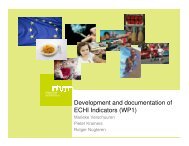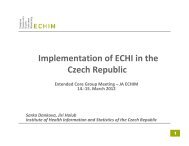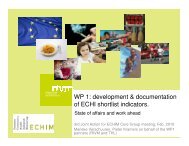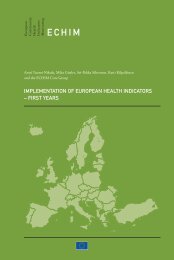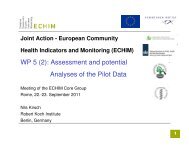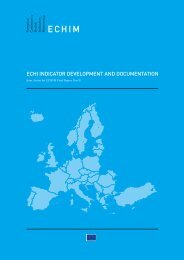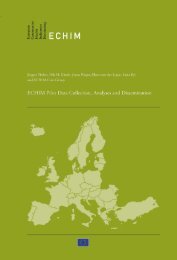INDICATORS
ECHIM Final Report
ECHIM Final Report
You also want an ePaper? Increase the reach of your titles
YUMPU automatically turns print PDFs into web optimized ePapers that Google loves.
Notes:<br />
Practising, professionally active, economically active and licensed to practise nursing and<br />
caring personnel are defined according to the Eurostat document: “Definitions and data<br />
collection specifications on health care statistics (non-expenditure data) Version 31 July<br />
2007”.<br />
Practising personnel provide services directly to patients. Professionally active personnel<br />
are practising personnel for whom their education is a prerequisite for the execution of the<br />
job. Economically active personnel are practising personnel as well as personnel who do<br />
NOT use their education for the purpose of the actual job. Licensed to practise personnel are<br />
practicing personnel, professionally active and economically active personnel, as well as all<br />
personnel being registered and entitled to practise their profession.<br />
Absolute number of posts (PP; “head count”) versus number of full time equivalent (FTE)<br />
posts. The number of working hours per week varies between countries, but normally should<br />
not be less than 35 hours. The number of FTE should be calculated by adding the full and<br />
appropriate proportion of part-time occupied posts.<br />
65. MOBILITY OF PROFESSINALS<br />
Definition: Mobility of health care professionals and personnel means the geographical<br />
movement of a health professional from one country to another in order to provide services<br />
or to establish himself/herself in another host Member State. The indicator can be designed<br />
in 2 ways:<br />
(1) The number and proportion of health care professionals emigrating<br />
(2) The number and proportion of health care professionals immigrating.<br />
Calculation: To be developed.<br />
1) Emigration: The number and proportion of health care professionals and personnel<br />
working in another than their county of origin or (permanent) resident country.<br />
2) Immigration: The number and proportion of health care professionals and personnel<br />
working in a given country but originating from a different country (immigration)<br />
Optionally: by profession (see below), by country-country combination(s).<br />
Notes: Important EU-health policy issue. How to define ‘country of origin’ and ‘country of<br />
residence’ has to be decided. The EU legislation has established different<br />
systems of recognition of professional qualifications. Dentists, medical doctors, midwives,<br />
nurses, pharmacists and veterinarians are covered by the so called “sectorial system”, in which<br />
meeting the minimum common criteria of the schooling/training standards defined in the<br />
relevant sectorial directives leads to the automatic recognition of the diploma in each MS.<br />
This mutual recognition of professional qualifications is intended to simplify access to the<br />
market (right of establishment) and to facilitate the cross-border provision of services for all<br />
types of professions.<br />
122



